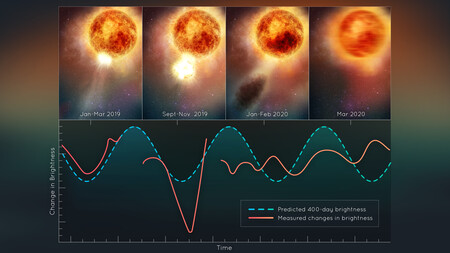We know that the outer atmosphere of the Sun is a very active place. The King Star usually expels part of its corona in what is known as coronal mass ejections (CME), events that give rise to solar storms that can put our communications in check. But in the vast and intriguing universe there are much more massive eruptions, like that of the red supergiant Betelgeuse, which ejected 400 billion million times more mass than a typical CME.
Betelgeuse is very well known. It is a bright red dot in the Orion constellation. Astronomers have been observing it for more than 200 years, but in 2019 they warned that something was happening to it. In an unusual behavior, the star suddenly began to dim, which led experts in the field to wonder what was the origin of this phenomenon. Were they facing the death of a red supergiant? Would it explode soon as a type II supernova?
Betelgeuse is slowly recovering
According to NASAanalysis of data from the Hubble Space Telescope and other observatories has led to the conclusion that Betelgeuse experienced a colossal surface mass ejection that caused it to lose much of its visible surface. And, although they do not finish explaining the details of the phenomenon, they assure that it will help to understand the final stage of the life of a star. “This is something never before seen in the behavior of a normal star,” says the US space agency.
The researchers believe that the flow inside the star generated shocks and pulsations that triggered the aforementioned ejection. As part of the phenomenon, part of Betelgeuse’s photosphere was released into space at a very high temperature. However, as it expanded, it lost temperature until it became a large cloud of dust that blocked out most of the starlight that could be seen from Earth for several months.
As shown in the image above, Betelgeuse had a darkening and brightening pulse that restarted every 400 days, but after the last dramatic event this was interrupted (perhaps momentarily). However, the latest observations indicate that the outer layer of the star is recovering and, scientists estimate, that the same is happening with its non-visible parts. “Betelgeuse is continuing to do some very unusual things right now; the interior is kind of bouncing around,” says Andrea Dupree of the Harvard-Smithsonian Center for Astrophysics.

These observations are very important for understanding how stars lose mass as they are consumed through nuclear fusion. While the amount of mass lost affects its fate, it is now believed that it is not necessarily a sign that it is close to exploding as a supernova, therefore surface mass ejections and coronal mass ejections could be different events. The next step for astronomers will be to observe Betelgeuse’s behavior with the powerful James Webb Space Telescope, which will make it possible to study the phenomenon in depth with its infrared instruments.
In Xataka | They observe the largest supernova ever recorded in the Universe: the explosion of a star at least 50 times larger than the Sun
















Add Comment